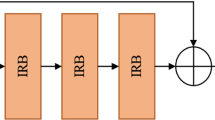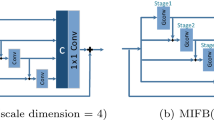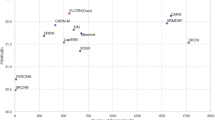Abstract
In recent years, single-image super-resolution (SISR) has made significant progress using convolutional neural networks. However, to achieve better performance, many methods deepen the network depth and stack a large number of parameters. Unfortunately, this leads to high computational complexity and is difficult to apply on ordinary intelligent devices used by the public. To address this issue, we propose a lightweight SISR network that uses thin convolutional groups to significantly reduce network size. We also optimize the network structure to compensate for the loss in performance caused by the reduction in the number of parameters. Our proposed CRUN(Cascade Compound Residual UNet Network) model utilizes cascade residuals structure as the backbone to deepen the network and increase its receptive field. We then use skip connections and dense connection structures to design deep feature extraction blocks that reduce the network’s dependence on feature dimensions. Moreover, we introduce a Multi-scale Feature Enhancement Block (MFEB) to fuse features at different levels, compensating for the weakness of thin convolutional groups in obtaining features. Our experimental results show that the CRUN model achieves superior performance compared to state-of-the-art lightweight models while requiring relatively fewer resources. This improvement makes our proposed model more practical and suitable for usage on everyday devices.










Similar content being viewed by others
Availability of data and materials
The data and materials that support the findings of this study are available from the corresponding author upon reasonable request.
Code Availability
Not applicable
References
Zhou F, Yang W, Liao Q (2012) Interpolation-based image super-resolution using multisurface fitting. IEEE Trans Image Process 21(7):3312–3318
Nayak R, Harshavardhan S, Patra D (2014) Morphology based iterative back-projection for super-resolution reconstruction of image. In: 2014 2nd International Conference on Emerging Technology Trends in Electronics, Communication and Networking, pp 1–6. IEEE
Mishra SR, Mishra TK, Sanyal G, Sarkar A, Satapathy SC (2020) Real time human action recognition using triggered frame extraction and a typical cnn heuristic. Pattern Recognit Lett 135:329–336
Dong C, Loy CC, He K, Tang X (2014) Learning a deep convolutional network for image super-resolution. In: Computer Vision–ECCV 2014: 13th European Conference, Zurich, Switzerland, September 6-12, 2014, Proceedings, Part IV 13, pp 184–199. Springer
Keys R (1981) Cubic convolution interpolation for digital image processing. IEEE Trans Acoust Speech Signal Process 29(6):1153–1160. https://doi.org/10.1109/TASSP.1981.1163711
Lim B, Son S, Kim H, Nah S, Lee KM (2017) Enhanced deep residual networks for single image super-resolution. In: The IEEE Conference on Computer Vision and Pattern Recognition (CVPR) Workshops
Zhang Y, Tian Y, Kong Y, Zhong B, Fu Y (2018) Residual dense network for image super-resolution. In: 2018 IEEE/CVF Conference on Computer Vision and Pattern Recognition, pp 2472–2481. https://doi.org/10.1109/CVPR.2018.00262
Zhang Y, Li K, Li K, Wang L, Zhong B, Fu Y (2018) Image super-resolution using very deep residual channel attention networks. In: Proceedings of the European Conference on Computer Vision (ECCV), pp 286–301
Tai Y, Yang J, Liu X (2017) Image super-resolution via deep recursive residual network. In: Proceedings of the IEEE Conference on Computer Vision and Pattern Recognition
Tai Y, Yang J, Liu X, Xu C (2017) Memnet: A persistent memory network for image restoration. In: Proceedings of International Conference on Computer Vision
Chollet F (2017) Xception: Deep learning with depthwise separable convolutions. In: Proceedings of the IEEE Conference on Computer Vision and Pattern Recognition (CVPR)
Liu S, Huang D, et al (2018) Receptive field block net for accurate and fast object detection. In: Proceedings of the European Conference on Computer Vision (ECCV), pp 385–400
He Y, Lin J, Liu Z, Wang H, Li L-J, Han S (2018) Amc: Automl for model compression and acceleration on mobile devices. In: Proceedings of the European Conference on Computer Vision (ECCV), pp 784–800
Ronneberger O, Fischer P, Brox T (2015) U-net: Convolutional networks for biomedical image segmentation. In: Medical Image Computing and Computer-Assisted Intervention–MICCAI 2015: 18th International Conference, Munich, Germany, October 5-9, 2015, Proceedings, Part III 18, pp 234–241. Springer
Lan R, Sun L, Liu Z, Lu H, Pang C, Luo X (2021) Madnet: A fast and lightweight network for single-image super resolution. IEEE Trans Cybern 51(3):1443–1453. https://doi.org/10.1109/TCYB.2020.2970104
Dong C, Loy CC, Tang X (2016) Accelerating the super-resolution convolutional neural network. In: Computer Vision–ECCV 2016: 14th European Conference, Amsterdam, The Netherlands, October 11-14, 2016, Proceedings, Part II 14, pp 391–407. Springer
Ledig C, Theis L, Huszár F, Caballero J, Cunningham A, Acosta A, Aitken A, Tejani A, Totz J, Wang Z, et al (2017) Photo-realistic single image super-resolution using a generative adversarial network. In: Proceedings of the IEEE Conference on Computer Vision and Pattern Recognition, pp 4681–4690
Howard AG, Zhu M, Chen B, Kalenichenko D, Wang W, Weyand T, Andreetto M, Adam H (2017) Mobilenets: Efficient convolutional neural networks for mobile vision applications. arXiv:1704.04861
Sandler M, Howard A, Zhu M, Zhmoginov A, Chen L-C (2018) Mobilenetv2: Inverted residuals and linear bottlenecks. In: Proceedings of the IEEE Conference on Computer Vision and Pattern Recognition, pp 4510–4520
Ahn N, Kang B, Sohn K-A (2018) Fast, accurate, and lightweight super-resolution with cascading residual network. In: Proceedings of the European Conference on Computer Vision (ECCV)
Hui Z, Wang X, Gao X (2018) Fast and accurate single image super-resolution via information distillation network. In: CVPR, pp 723–731
Hui Z, Gao X, Yang Y, Wang X (2019) Lightweight image super-resolution with information multi-distillation network. In: Proceedings of the 27th ACM International Conference on Multimedia (ACM MM), pp 2024–2032
Li B, Wang B, Liu J, Qi Z, Shi Y (2020) s-lwsr: Super lightweight super-resolution network. IEEE Transactions on Image Processing 29:8368–8380
Li J, Fang F, Mei K, Zhang G (2018) Multi-scale residual network for image super-resolution. In: Proceedings of the European Conference on Computer Vision (ECCV), pp 517–532
Zoph B, Vasudevan V, Shlens J, Le QV (2018) Learning transferable architectures for scalable image recognition. In: Proceedings of the IEEE Conference on Computer Vision and Pattern Recognition, pp 8697–8710
Chu X, Zhang B, Ma H, Xu R, Li Q (2021) Fast, accurate and lightweight super-resolution with neural architecture search. In: 2020 25th International Conference on Pattern Recognition (ICPR), pp 59–64. IEEE
Shi W, Caballero J, Huszár F, Totz J, Aitken AP, Bishop R, Rueckert D, Wang Z (2016) Real-time single image and video super-resolution using an efficient sub-pixel convolutional neural network. In: Proceedings of the IEEE Conference on Computer Vision and Pattern Recognition, pp 1874–1883
Odena A, Dumoulin V, Olah C (2016) Deconvolution and checkerboard artifacts. Distill. https://doi.org/10.23915/distill.00003
Huang G, Liu Z, Van Der Maaten L, Weinberger KQ (2017) Densely connected convolutional networks. In: Proceedings of the IEEE Conference on Computer Vision and Pattern Recognition, pp 4700–4708
Szegedy C, Ioffe, S, Vanhoucke V, Alemi A (2017) Inception-v4, inception-resnet and the impact of residual connections on learning. In: Proceedings of the AAAI Conference on Artificial Intelligence, vol. 31
Wang X, Yu K, Wu S, Gu J, Liu Y, Dong C, Qiao Y, Change Loy C (2018) Esrgan: Enhanced super-resolution generative adversarial networks. In: Proceedings of the European Conference on Computer Vision (ECCV) Workshops, pp 0–0
He K, Zhang X, Ren S, Sun J (2015) Delving deep into rectifiers: Surpassing human-level performance on imagenet classification. In: Proceedings of the IEEE International Conference on Computer Vision, pp 1026–1034
Timofte R, Agustsson E, Van Gool L, Yang M-H, Zhang L (2017) Ntire 2017 challenge on single image super-resolution: Methods and results. In: Proceedings of the IEEE Conference on Computer Vision and Pattern Recognition Workshops, pp 114–125
Bevilacqua M, Roumy A, Guillemot C, Alberi-Morel ML (2012) Low-complexity single-image super-resolution based on nonnegative neighbor embedding
Zeyde R, Elad M, Protter M (2012) On single image scale-up using sparse-representations. In: Curves and Surfaces: 7th International Conference, Avignon, France, June 24-30, 2010, Revised Selected Papers 7, pp 711–730. Springer
Arbelaez P, Maire M, Fowlkes C, Malik J (2010) Contour detection and hierarchical image segmentation. IEEE trans pattern anal mach intell 33(5):898–916
Huang J-B, Singh A, Ahuja N (2015) Single image super-resolution from transformed self-exemplars. In: Proceedings of the IEEE Conference on Computer Vision and Pattern Recognition, pp 5197–5206
Wang Z, Chen J, Hoi SC (2020) Deep learning for image super-resolution: A survey. IEEE trans pattern anal mach intell 43(10):3365–3387
Kingma DP, Ba J (2014) Adam: A method for stochastic optimization. arXiv:1412.6980
Luo X, Xie Y, Zhang Y, Qu Y, Fu Y (2020) Latticenet: Towards lightweight image super-resolution with lattice block. European Conf Comput Vis
Park K, Soh JW, Cho NI (2021) Dynamic residual self-attention network for lightweight single image super-resolution. IEEE Trans Multimed 1–1. https://doi.org/10.1109/TMM.2021.3134172
Li Z, Liu Y, Chen X, Cai H, Gu J, Qiao Y, Dong C (2022) Blueprint separable residual network for efficient image super-resolution. In: Proceedings of the IEEE/CVF Conference on Computer Vision and Pattern Recognition (CVPR) Workshops, pp 833–843
Kim J, Lee JK, Lee KM (2016) Accurate image super-resolution using very deep convolutional networks. In: Proceedings of the IEEE Conference on Computer Vision and Pattern Recognition, pp 1646–1654
Lai W-S, Huang J-B, Ahuja N, Yang M-H (2017) Deep laplacian pyramid networks for fast and accurate super-resolution. In: IEEE Conferene on Computer Vision and Pattern Recognition
Zhang K, Zuo W, Zhang L (2018) Learning a single convolutional super-resolution network for multiple degradations. In: IEEE Conference on Computer Vision and Pattern Recognition, pp 3262–3271
Li W, Zhou K, Qi L, Jiang N, Lu J, Jia J (2020) Lapar: Linearly-assembled pixel-adaptive regression network for single image super-resolution and beyond. Adv Neural Inf Process Syst 33
Gao D, Zhou D (2023) A very lightweight and efficient image super-resolution network. Exp Syst Appl 213:118898. https://doi.org/10.1016/j.eswa.2022.118898
Funding
Partial financial support was received from the National Key Research and Development Program (No. 2018YFB2100100).
Author information
Authors and Affiliations
Contributions
Xingji Huang: Conceptualization, Methodology, Formal analysis, Writing - Original Draft. Yuxing Mao: Writing - Review & Editing. Jian Li: Supervision, Project administration. Shunxin Wu: Data Curation. Xueshuo Chen: Resources. Hang Lu: Software.
Corresponding author
Ethics declarations
Competing interest
The authors have no competing interests to declare that are relevant to the content of this article.
Ethical approval
Not applicable
Consent to participate
Not applicable
Consent to publication
Not applicable
Additional information
Publisher's Note
Springer Nature remains neutral with regard to jurisdictional claims in published maps and institutional affiliations.
Rights and permissions
Springer Nature or its licensor (e.g. a society or other partner) holds exclusive rights to this article under a publishing agreement with the author(s) or other rightsholder(s); author self-archiving of the accepted manuscript version of this article is solely governed by the terms of such publishing agreement and applicable law.
About this article
Cite this article
Huang, X., Mao, Y., Li, J. et al. CRUN: a super lightweight and efficient network for single-image super resolution. Appl Intell 53, 29557–29569 (2023). https://doi.org/10.1007/s10489-023-05077-3
Accepted:
Published:
Issue Date:
DOI: https://doi.org/10.1007/s10489-023-05077-3




